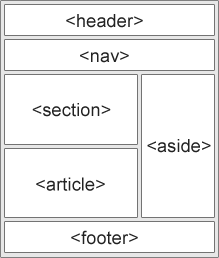HTML5 Semantic Elements
Semantics is the study of the meanings of words and phrases in a language.
Semantic elements = elements with a meaning.
What are Semantic Elements?
A semantic element clearly describes its meaning to both the browser and the developer.
Examples of non-semantic elements: <div> and <span> - Tells nothing about its content.
Examples of semantic elements: <form>, <table>, and <article> - Clearly defines its content.
Browser Support
| Yes | Yes | Yes | Yes | Yes |
HTML5 semantic elements are supported in all modern browsers.
In addition, you can "teach" older browsers how to handle "unknown elements".
Read about it in HTML5 Browser Support.
New Semantic Elements in HTML5
Many web sites contain HTML code like:
<div id="nav"> <div class="header"> <div id="footer">
to indicate navigation, header, and footer.
HTML5 offers new semantic elements to define different parts of a web page:
- <article>
- <aside>
- <details>
- <figcaption>
- <figure>
- <footer>
- <header>
- <main>
- <mark>
- <nav>
- <section>
- <summary>
- <time>

HTML5 <section> Element
The <section> element defines a section in a document.
According to W3C's HTML5 documentation: "A section is a thematic grouping of content, typically with a heading."
A home page could normally be split into sections for introduction, content, and contact information.
Example
<section>
<h1>WWF</h1>
<p>The World Wide Fund for Nature (WWF) is....</p>
</section>
Try it Yourself »
HTML5 <article> Element
The <article> element specifies independent, self-contained content.
An article should make sense on its own, and it should be possible to read it independently from the rest of the web site.
Examples of where an <article> element can be used:
- Forum post
- Blog post
- Newspaper article
Example
<article>
<h1>What Does WWF Do?</h1>
<p>WWF's mission is to stop the degradation of our planet's natural environment,
and build a future in which humans live in harmony with nature.</p>
</article>
Try it Yourself »
Nesting <article> in <section> or Vice Versa?
The<article>
element specifies independent, self-contained content.
The <section> element defines section in a document.
Can we use the definitions to decide how to nest those elements? No, we cannot!
So, on the Internet, you will find HTML pages with <section> elements
containing <article> elements, and <article> elements containing <section> elements.
You will also find pages with <section> elements containing <section>
elements, and <article> elements containing <article> elements.
Example for a newspaper: The sport <article> in the sport section,
may have a technical section in each <article>.
HTML5 <header> Element
The <header> element specifies a header for a document or section.
The <header> element should be used as a container for introductory content.
You can have several <header> elements in one document.
The following example defines a header for an article:
Example
<article>
<header>
<h1>What Does WWF Do?</h1>
<p>WWF's mission:</p>
</header>
<p>WWF's mission is to stop the degradation of our planet's natural environment,
and build a future in which humans live in harmony with nature.</p>
</article>
Try it Yourself »
HTML5 <footer> Element
The <footer> element specifies a footer for a document or section.
A <footer> element should contain information about its containing element.
A footer typically contains the author of the document, copyright information, links to terms of use, contact information, etc.
You may have several <footer> elements in one document.
Example
<footer>
<p>Posted by: Hege Refsnes</p>
<p>Contact information: <a href="mailto:someone@example.com">
someone@example.com</a>.</p>
</footer>
Try it Yourself »
HTML5 <nav> Element
The <nav> element defines a set of navigation links.
Notice that NOT all links of a document should be inside a <nav> element. The
<nav> element is intended only for major block of navigation links.
Example
<nav>
<a href="/html/">HTML</a> |
<a href="/css/">CSS</a> |
<a href="/js/">JavaScript</a> |
<a href="/jquery/">jQuery</a>
</nav>
Try it Yourself »
HTML5 <aside> Element
The <aside> element defines some content aside from the content it is
placed in (like a sidebar).
The <aside> content should be related to the surrounding content.
Example
<p>My family and I visited The Epcot center this summer.</p>
<aside>
<h4>Epcot Center</h4>
<p>The Epcot Center is a theme park in Disney World, Florida.</p>
</aside>
Try it Yourself »
HTML5 <figure> and <figcaption> Elements
The purpose of a figure caption is to add a visual explanation to an image.
In HTML5, an image and a caption can be grouped together in a <figure>
element:
Example
<figure>
<img src="pic_mountain.jpg" alt="The Pulpit Rock" width="304" height="228">
<figcaption>Fig1. - The Pulpit Rock, Norway.</figcaption>
</figure>
Try it Yourself »
The <img> element defines the image, the <figcaption>
element defines the caption.
Why Semantic Elements?
With HTML4, developers used their own id/class names to style elements: header, top, bottom, footer, menu, navigation, main, container, content, article, sidebar, topnav, etc.
This made it impossible for search engines to identify the correct web page content.
With the new HTML5 elements (<header> <footer> <nav> <section> <article>), this
will become easier.
According to the W3C, a Semantic Web: "Allows data to be shared and reused across applications, enterprises, and communities."
Semantic Elements in HTML5
Below is an alphabetical list of the new semantic elements in HTML5.
The links go to our complete HTML5 Reference.
| Tag | Description |
|---|---|
| <article> | Defines an article |
| <aside> | Defines content aside from the page content |
| <details> | Defines additional details that the user can view or hide |
| <figcaption> | Defines a caption for a <figure> element |
| <figure> | Specifies self-contained content, like illustrations, diagrams, photos, code listings, etc. |
| <footer> | Defines a footer for a document or section |
| <header> | Specifies a header for a document or section |
| <main> | Specifies the main content of a document |
| <mark> | Defines marked/highlighted text |
| <nav> | Defines navigation links |
| <section> | Defines a section in a document |
| <summary> | Defines a visible heading for a <details> element |
| <time> | Defines a date/time |

